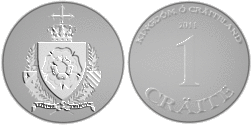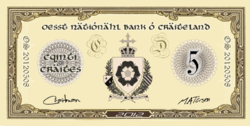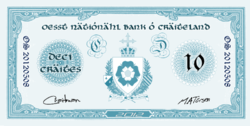Craitish Cräite: Difference between revisions
mNo edit summary |
No edit summary |
||
| Line 9: | Line 9: | ||
| coins = 1c, 2c, 5c, 10c,<br>20c, 50c, ₢1, ₢2 | | coins = 1c, 2c, 5c, 10c,<br>20c, 50c, ₢1, ₢2 | ||
| users = {{team flag|Craitland}}<br>[[File:FMF logo.png|25px|border|FMF]] [[FMF]] | | users = {{team flag|Craitland}}<br>[[File:FMF logo.png|25px|border|FMF]] [[FMF]] | ||
| unofficial = | | unofficial = | ||
| peg = | | peg = | ||
}} | }} | ||
Latest revision as of 11:58, 2 February 2023
| Craitish Cräite | |
 | |
| Denominations | |
|---|---|
| Subunit | |
| 1⁄100 | Cräi |
| Symbol | ₢, Cr |
| Banknotes | ₢5, ₢10, ₢20 |
| Coins |
1c, 2c, 5c, 10c, 20c, 50c, ₢1, ₢2 |
| Demographics | |
| User(s) |
|
The Cräite, also referred to as the Craitish Cräite, is the official currency of Craitland and, formerly, of Hurmu. It is divided into one hundred cräi.
Usage
The Cräite is used as the sole official currency in Craitland, and was also used officially alongside regional currencies in its autonomous territories of Incontinentia, Lakkvia, New Vaduz and Zandarijn prior to the "Great Consolidation". Due to historical reasons, Talenore, when under Craitish sovereignty, used only its own dollar.
The Cräite is well-known internationally due to its adoption of usage by the FMF, Micras' association football organising body, for aspects including official payments of penalty fines and player transfer dealings.
The independent nation of Mercury has also unofficially adopted the Cräite as its currency alongside the pegged Mercury Credit.
In Hurmu
In the build-up to the reformation of the Hurmu state, following the reunion of Lakkvia with the Hurmu Trust Territory, it was decided that the Craitish currency would remain official in the reunited Hurmu. Known as kret (pl. kretar, abbreviated kr) in Hurmu Norse, the country had its own banknotes and coins. Without a central bank, four of Hurmu's commercial banks produced their own banknotes, all of which were legal tender across Hurmu, with a state-run mint producing the coins.
In practice, however, most transactions were electronic.
Hurmu considered Craitish banknotes and coins legal tender. Hurmu banknotes and coins were infrequently accepted as legal tender in Craitish establishments, with areas more popular with tourists being the most accepting, though banks throughout the country would offer exchanges into Craitish cash for ease without charge.
Following the introduction of an independent Hurmu currency in 1705 AN, the crown, the Cräite ceased to be legal tender in Hurmu.
Symbols and name
The Cräite's official symbol is ₢. However, due to occasional coding restraints and ease of typing, Cr is used interchangeably online and in print, even by official Craitish sources, and is an equally valid representation of the currency. Cr also prevails in written usage, when the long-form name is not required.
Domestic convention with the Cräite's name, as enshrined by both the Craitish government and minting Bank of Craitland, is to be spelled with an initial capital letter, which is contrary to common linguistic procedure with the names of currencies. However, outside of Craitland, it is often known as the cräite as a result of the prevailing standard.
Images
| |||||||||||||||||||||||||||||



